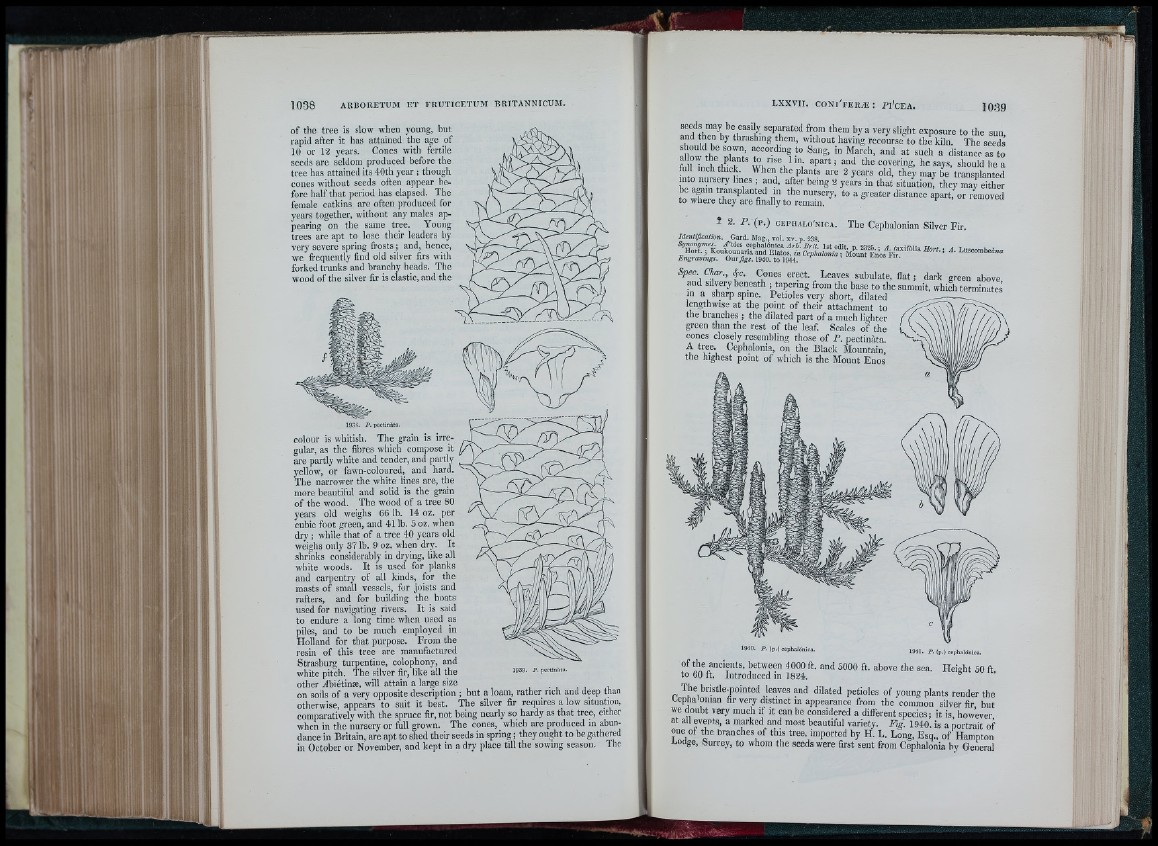
1 0 3 8 AR BO RE TUM E T F R U T IC E T UM B R ITA N N ICUM .
of the tree is slow when young, but
rapid after it has attained the age of
10 or 12 years. Cones with fertile
seeds are seldom produced before the
tree has attained its 40th year ; though
cones without seeds often appear before
half that period has elapsed. The
female catkins are often produced for
years together, without any males appearing
on the same tree. Young
trees are apt to lose their leaders hy
very severe spring frosts; and, hence,
we frequently find old silver firs with
forked trunks and branchy heads. The
wood of the silver fir is elastic, and the
1938. P . pectinàta.
colour is whitish. The grain is irregular,
as the fibres which compose it
are partly white and tender, and partly
yellow, or fawn-coloured, and hard.
The narrower the white lines are, the
more beautiful and solid is the grain
of the wood. The wood of a tree 80
years old weighs 6 6 lb. 14 oz. per
cubic foot green, and 41 lb. 5 oz. when
dry ; while that of a tree 40 years old
weighs only 37 lb. 9 oz. when dry. It
shrinks considerably in drying, like all
white woods. It is used for planks
and carpentry of all kinds, for the
masts of small vessels, for joists and
rafters, and for building the boats
used for navigating rivers. It is said
to endure a long time when used as
piles, and to be much employed in
Holland for that purpose. From the
resin of this tree are manufactured
Strasburg turpentine, colophony, and
white pitch. The silver fir, like all the
.1 - -11 to Ito— totèT«
1939. P . pectinîlta.
O th e r Ab ie tin se , will a tt a in a la rg e siz e
o n so ils o f a v e ry o p p o s ite d e s c r ip tio n ; b u t a lo am , r a t h e r r ic h a n d d e e p than
o th e rw is e , a p p e a r s t o s u it i t b e s t. T h e s ilv e r fir r e q u ir e s a low s itu a tio n ,
c om p a r a tiv e ly w ith th e s p ru c e fir, n o t b e in g n e a rly s o h a rd y a s t h a t t r e e , either
w h e n in th e n u r s e r y o r fu ll g row n . T h e c o n e s , w h ic h a r e p ro d u c e d in ab u n d
a n c e i n B r ita in , a r e a p t t o s h e d th e i r s e e d s in s p r in g ; th e y o u g h t to b e gathCTed
in O c to b e r o r N o v em b e r, a n d k e p t in a d ry p la c e till th e sow in g s e a s o n . The
LX X V II. c o n i ' f e r æ : p i 'c e a . 1 0 3 9
separated from them by a very slight exposure to the sun,
and then by thrashing them, witliout having recourse to the kiln. The seeds
“ M»roh, and at such a distance as to
fuinnchthfok" "i “ fo the full inch thick. When the plants are 2 years cooldv,e rtihnegy, mhea ys abyes , trsahnosupllda nbtee da
into nursery lines ; and, after being 2 years in that situation, they ma/either
to w fe!V tr;?!e f i l l i ; t e Y e t e r ' ' ' ' ’ " P " ' ’ " ‘ " “ " r e f o
i 2. P. (p.) C E P H A L O 'N IO A . The Cephalonian Silver Fir.
Identification. Gard. Mag., vol. xv. p. 238
Spec Char., f r . Cones erect. Leaves subulate, flat ; dark green above
and silvery beneath .^tapering from the base to the summit, which terminates
m a sharp spine. Petioles very short, dilated
lengthwise at the point of their attachment to
the branches ; the dilated part of a much lighter
green than the rest of the leaf. Scales of the
cones closely resembling those of P. pectinàta.
A tree. Cephalonia, on the Black Mountain,
the highest point of which is the Mount Enos
1940. />. (p.) » p h a l i n i c . 154, . e . ,p ., e , p i „ , 3 „ , „ .
o( the ancients, between 4000 ft. and 5000 ft. above the sea. Height 50 ft.
to 60 ft. Introduced in 1824.
The bristle-pointed leaves and dilated petioles of young plants render the
Lcpha'onian fir very distinct in appearance from the common silver fir, but
we doubt very much if it can be considered a différent species ; it is however
at all everffi, a marked and most beautiful variety. Fig. 1940. is a portrait of
one of the branches of this tree, imported by H. L. Long, Esq., of Hampton
Lodge, Surrey, to whom the seeds were first sent from Cephalonia hy General